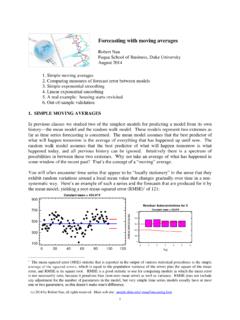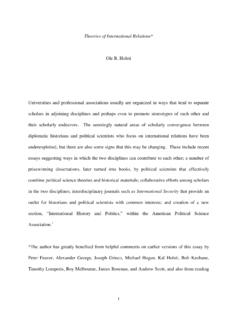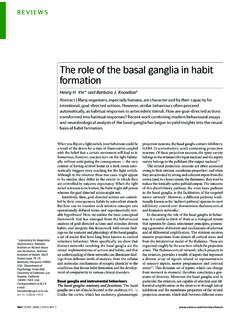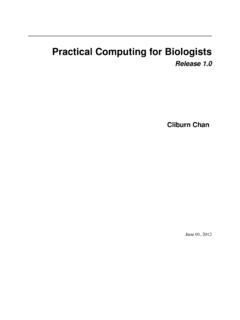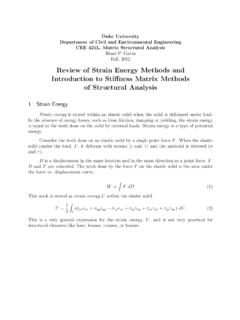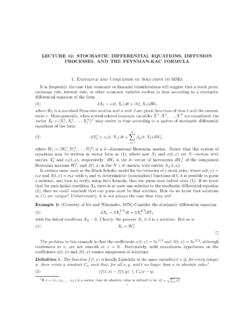Transcription of Slides on ARIMA models--Robert Nau - Duke University
1 1 Lecture notes on forecastingRobert NauFuqua School of BusinessDuke UniversityIntroduction to ARIMA models Nonseasonal ~ (c) 2014 by Robert Nau, all rights reservedARIMA models Auto-Regressive Integrated Moving Average Are an adaptation of discrete-time filtering methods developed in 1930 s-1940 s by electrical engineers (Norbert Wiener et al.) Statisticians George Box and Gwilym Jenkins developed systematic methods for applying them to business & economic data in the 1970 s (hence the name Box-Jenkins models )2 What ARIMA stands for A series which needs to be differenced to be made stationary is an integrated (I) series Lags of the stationarized series are called auto-regressive (AR) terms Lags of the forecast errors are called moving average (MA) terms We ve already studied these time series tools separately.
2 Differencing, moving averages, lagged values of the dependent variable in regressionARIMA models put it all together Generalized random walk modelsfine-tuned to eliminate all residual autocorrelation Generalized exponential smoothing modelsthat can incorporate long-term trends and seasonality Stationarized regression modelsthat use lags of the dependent variables and/or lags of the forecast errors as regressors The most general class of forecasting models for time series that can be stationarized*by transformations such as differencing, logging, and or deflating* A time series is stationary if all of its statistical properties mean, variance, autocorrelations, etc. are constant in time. Thus, it has no trend, no heteroscedasticity, and a constant degree of wiggliness. 3 Construction of an ARIMA series, if necessary, by differencing (& perhaps also logging, deflating, etc.)
3 2. Study the pattern of autocorrelationsand partial autocorrelationsto determine if lags of the stationarized series and/or lags of the forecast errors should be included in the forecasting equation3. Fit the model that is suggested and check its residual diagnostics, particularly the residual ACF and PACF plots, to see if all coefficients are significant and all of the pattern has been Patterns that remain in the ACF and PACF may suggest the need for additional AR or MA termsARIMA terminology A non-seasonal ARIMA model can be (almost) completely summarized by three numbers:p= the number of autoregressivetermsd= the number of nonseasonal differencesq= the number of moving-averageterms This is called an ARIMA (p,d,q) model The model may also include a constantterm (or not)4 The ARIMA filtering box 012p012d012qtime series signal (forecasts) noise (residuals)Objective: adjust the knobs until the residuals are white noise (uncorrelated)constant?
4 XIn Statgraphics:pqdARIMA options are available when model type = ARIMA5 ARIMA models we ve already met ARIMA (0,0,0)+c = mean (constant) model ARIMA (0,1,0) = RW model ARIMA (0,1,0)+c = RW with drift model ARIMA (1,0,0)+c = regress Y on Y_LAG1 ARIMA (1,1,0)+c = regr. Y_DIFF1 on Y_DIFF1_LAG1 ARIMA (2,1,0)+c = plus Y_DIFF_LAG2 as well ARIMA (0,1,1) = SES model ARIMA (0,1,1)+c = SES + constant linear trend ARIMA (1,1,2) = LES w/ damped trend (leveling off) ARIMA (0,2,2) = generalized LES (including Holt s) ARIMA forecasting equation Let Ydenote the originalseries Let ydenote the differenced(stationarized) seriesNo difference (d=0): yt = YtFirst difference(d=1): yt = Yt Yt-1 Second difference (d=2): yt = (Yt Yt-1) (Yt-1 Yt-2)= Yt 2Yt-1 + Yt-2 Note that the second difference is not just the change relative to two periods ago, , it is not Yt Yt-2.
5 Rather, it is the change-in-the-change, which is a measure of local acceleration rather than equation for yNot as bad as it looks! Usually p+q 2 and either p=0 or q=0 (pure AR or pure MA model)ptpttyyy .. 11qtqtee ..11constantAR terms (lagged values of y)MA terms (lagged errors)By convention, the AR terms are + and the MA terms are Undifferencing the forecastttyYd :0If 1 :1If tttYyYd212 :2If ttttYYyYdThe differencing (if any) must be reversedto obtain a forecast for the original series:Fortunately, your software will do all of this automatically!7Do you need both AR and MA terms? In general, you don t: usually it suffices to use only one type or the other. Some series are better fitted by AR terms, others are better fitted by MA terms (at a given level of differencing). Rough rules of thumb: If the stationarized series has positive autocorrelation at lag 1, AR terms often work best.
6 If it has negative autocorrelation at lag 1,MA terms often work best. An MA(1) term often works well to fine-tune the effect of a nonseasonal difference, while an AR(1) term often works well to compensate for the lack of a nonseasonal difference, so the choice between them may depend on whether a difference has been of AR terms A series displays autoregressive (AR) behavior if it apparently feels a restoring force that tends to pull it back toward its mean. In an AR(1) model, the AR(1) coefficient determines how fast the series tends to return to its mean. If the coefficient is near zero, the series returns to its mean quickly; if the coefficient is near 1, the series returns to its mean slowly. In a model with 2 or more AR coefficients, the sum of the coefficients determines the speed of mean reversion, and the series may also show an oscillatory of MA terms A series displays moving-average (MA) behavior if it apparently undergoes random shocks whose effects are felt in two or more consecutive periods.
7 The MA(1) coefficient is (minus) the fraction of last period s shock that is still felt in the current period. The MA(2) coefficient, if any, is (minus) the fraction of the shock two periods ago that is still felt in the current period, and so for identifying ARIMA models: ACF and PACF plots The autocorrelation function (ACF) plot shows the correlationof the series with itselfat different lags The autocorrelation of Yat lag kis the correlation between Yand LAG(Y,k) The partialautocorrelation function (PACF) plot shows the amount of autocorrelation at lag kthat is not explained by lower-order autocorrelations The partial autocorrelation at lag kis the coefficient of LAG(Y,k) in an AR(k) model, , in a regression of Yon LAG(Y, 1), LAG(Y,2), .. up to LAG(Y,k)9AR and MA signatures ACF that dies out gradually and PACF that cuts off sharply after a few lags AR signature An AR series is usually positively autocorrelated at lag 1(or even borderline nonstationary) ACF that cuts off sharply after a few lags and PACF that dies out more gradually MA signature An MA series is usually negatively autcorrelated at lag 1(or even mildly overdifferenced)AR signature: mean-reverting behavior, slow decay in ACF (usually positive at lag 1), sharp cutoff after a few lags in the signature is AR(2) because of 2 spikes in signature: noisy pattern, sharp cutoff in ACF (usually negative at lag 1), gradual decay in the signature is MA(1) because of 1 spike in or MA?
8 It depends! Whether a series displays AR or MA behavior often depends on the extent to which it has been differenced. An underdifferenced series has an AR signature (positive autocorrelation) After one or more orders of differencing, the autocorrelation will become more negative and an MA signature will emerge Don t go too far: if series already has zero or negative autocorrelation at lag 1, don t difference again11 The autocorrelation spectrumNonstationary Auto-Regressive White Noise Moving-Average Overdifferenced Positive autocorrelation No autocorrelation Negative autocorrelation add ARadd DIFFadd MAadd DIFF remove DIFFM odel-fitting steps1. Determine the order of differencing2. Determine the numbers of AR & MA terms3. Fit the model check to see if residuals are white noise, highest-order coefficients are significant (w/ no unit roots ), and forecasts look reasonable.
9 If not, return to step 1 or other words, move right or left in the autocorrelation spectrum by appropriate choices of differencing and AR/MA terms, until you reach the center (white noise)12 Units exampleOriginal series: nonstationary 1stdifference: AR signature 2nddifference: MA signature With one order of differencing, AR(1) or AR(2) is suggested, leading to ARIMA (1,1,0)+c or (2,1,0)+c13 With two orders of differencing, MA(1) is suggested, leading to ARIMA (0,2,1)For comparison, here is Holt s model: similar to ARIMA (0,1,2), but narrower confidence limits in this particular case14 ARIMA (1,1,2) = LES with damped trend ARIMA (1,1,2)All models that involve at least one order of differencing (a trend factor of some kind) are better than SES (which assumes no trend). ARIMA (1,1,2) is the winner over the others by a small issues Backforecasting Estimation algorithm begins by forecasting backward into the past to get start-up values Unit roots Look at sum of AR coefficients and sum of MA coefficients if they are too close to 1 you may want to consider higher or lower of differencing Overdifferencing A series that has been differenced one too many times will show verystrong negative autocorrelation and a strong MA signature, probably with a unit root in MA coefficientsSeasonal ARIMA models We ve previously studied three methods for modeling seasonality.
10 Seasonal adjustment Seasonal dummy variables Seasonally lagged dependent variable in regression A 4thapproach is to use a seasonal ARIMA model Seasonal ARIMA models rely on seasonal lags and differencesto fit the seasonal pattern Generalizes the regression approach16 Seasonal ARIMA terminology The seasonal part of an ARIMA model is summarized by three additionalnumbers:P= # of seasonal autoregressivetermsD= # of seasonal differencesQ= # of seasonal moving-averageterms The complete model is called an ARIMA (p,d,q) (P,D,Q) modelThe filtering box now has 6 knobs:012p012d012qtime series signal (forecasts) noise (residuals)Note that P, D, and Qshould never be larger than 1 !!P01DQ0101 Xconstant?17In Statgraphics:PQDS easonal ARIMA options are available when model type = ARIMA and a number has been specified for seasonality on the data input differences How non-seasonal & seasonal differences are combined to stationarize the series:If d=0, D=1:yt = Yt Yt-sIf d=1, D=1:yt = (Yt Yt-1) (Yt-s Yt-s-1)= Yt Yt-1 Yt-s+ Yt-s-1 Dshould never be more than 1, and d+Dshould never be more than 2.
